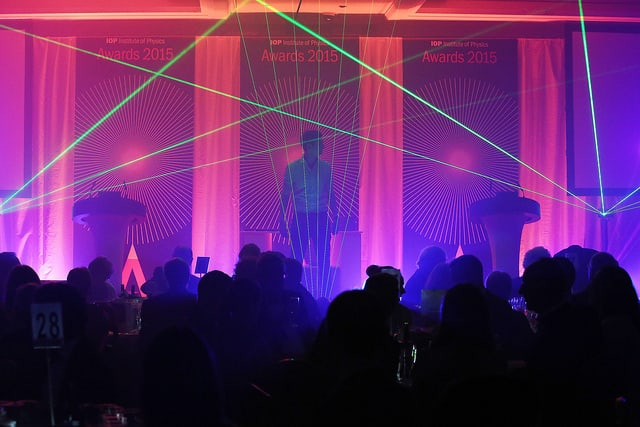
By Matin Durrani
And so to London last night to attend the annual awards dinner of the Institute of Physics, which publishes Physics World.
It’s a time when the Institute recognizes physicists who are making a “remarkable contribution” to physics, with awards going to teachers, researchers and businesses – as well as those who’ve served the Institute, shown best practice in professional development, and the university departments that have tackled the under-representation of women in physics. International awards are given too.
It being the International Year of Light, guests were also treated to two spectacular stage shows. Having just settled into our seats, we first watched as three dancers performed in front of lasers, dry ice and strobe lighting (see photo above) – certainly a first for an Institute awards dinner – while after the meal we were treated to a troupe called Feeding the Fish.
Their dancers carry laser batons to create “one-of-a-kind performances that fuse tight choreography with…specialized lighting effects”, with the batons being used to show everything from triangles and butterflies to even the logo of the Institute of Physics. Quite how it all worked certainly had physicists in the audience scratching their heads.
Over the meal I chatted to Andrew Taylor, who is executive director of the UK’s Science and Technologies Research Council, as well as Peter van der Burgt from Maynooth University in Ireland. Taylor has his fingers in lots of funding pies so it was a chance to get the inside track on funding and policy, while van der Burgt mentioned a 19th-century Irish priest called Nicholas Callan whose work on the induction coil I’d never come across before. Also on my table was Sir Michael Berry, whose talk earlier in the week had just been covered by my colleague Kate Gardner. It’s a small world.
Afterwards I caught up with Eli Yablonovitch, who’d won the Institute’s top gong – the Isaac Newton medal. An optoelectronics researcher at the University of California, Berkeley, who coined the term “photonic crystal”, Yablonovitch is that rare breed: a top researcher and an innovator, who runs four different physics-based businesses – one of which, Ethertronics, has produced more than a billion antennas used on mobile phones.
He was delighted to win the award, but as I travelled back to Bristol on the last train home, I wondered how many of my fellow passengers tapping, swiping and gaping at their own mobile devices will have heard of him – or are even aware of the role that physics plays in these indispensible devices.



